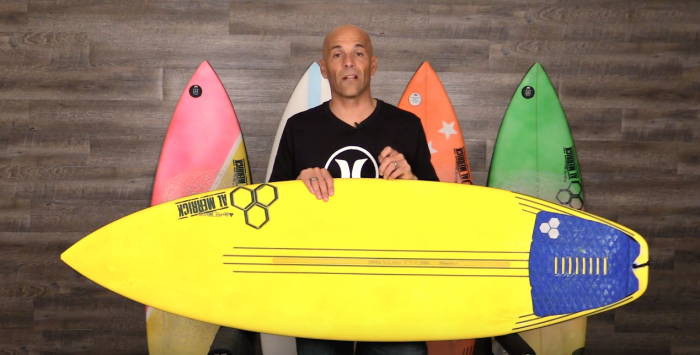SAMPLER in 5 different constructions
In this episode, Noel takes the Sampler in 5 different surfboards all made in different constructions with the exact same dimensions. Salas talks about these boards and what makes them so different and how they feel under his feet.
The industry standard construction is Polyurethane with Polyester resin (PU/PE), and the whole review is based on feel in comparison to what most surfers are accustomed to the PU/PE.
Board number 1 is the PU/PE, and Salas talks about flex, feel and cost. Noel has been riding this type of construction since he was 9 years old. When he rides other board types, he naturally compares them to the PU/PE. The cost of the PU/PE is $695.00, which is not cheap by any means, and the longevity of its life can be relatively short from a surfer’s perspective. The PU/PE is not Eco friendly and, because of this, many different companies are coming up with alternative constructions that are more compatible with planet earth.
Board 2 is what the surf world calls EPS, and this is a Expanded Polystyrene foam that is glassed with an Epoxy resin. Expanded foam is a open cell foam that is susceptible to taking in water if the glass is cracked, and the surfer does not fix it right away. This foam type is very light and more durable than PU/PE and can be a bit difficult to work with for shapers. The cost for this type of foam and epoxy resin is a bit more expensive because of this difficulty. The cost of Noel’s EPS board in this review is $820.00, which is $125.00 more compared to the PU/PE.
Board 3, the Flexbar, is much like the EPS (board 2) because it uses the same Expanded Polystyrene foam core and Epoxy resin but has a completely different application for performance purposes. There are 2 pieces of Expanded Polystyrene foam that sandwich a thin layer of high-density foam throughout the entire board. The top piece of foam has the deck routed out to place in a hand-shaped high-density bar for the board’s strength and to control the flex characteristics of the board. The cost on the Flexbar is $885.00, which is $190.00 more than a PU/PE.
Board 4 is called XTR, and it’s an Extruded Polystyrene foam core with an Epoxy resin. This foam core is a closed-cell foam, which will not let water penetrate into the core and will give this board a longer life. There are many benefits to this type of foam and it’s worth it’s weight in value for the surfer who is looking for a board with great flex characteristics and durability. The cost for this board is $815.00, and it’s one of Noel’s favorites.
Board 5 is called Varial foam, which is a proprietary formula and can be glassed with either Epoxy or Polyester resin. Noel had this one done with Epoxy resin to compare with the other models. Salas said he struggled with the Epoxy resin finish because of its stiff flex characteristics. The cost of this board came in at $1,000.00, and Noel recommends to the surf community to go with the Polyester resin for better flex at a cost of $880.00. Noel did a review on the Varial foam core with Polyester resin as he is a big fan of this combination.

